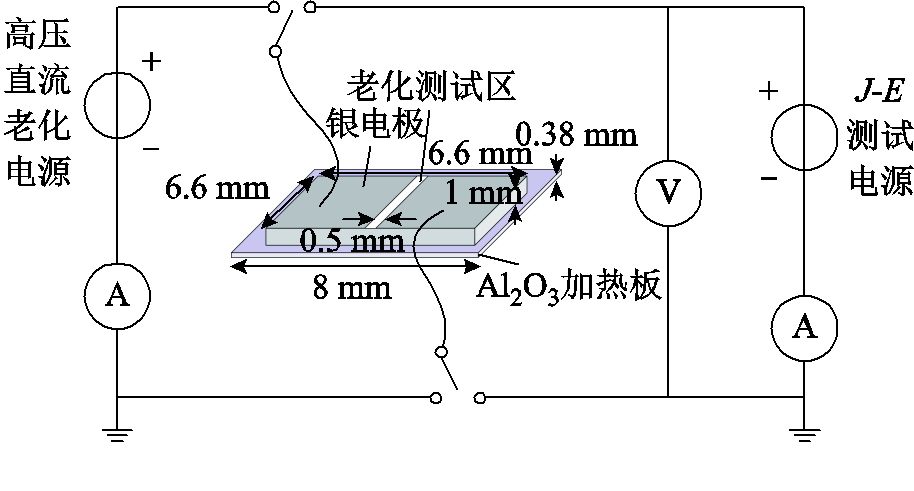
图1 离线理化性能测试系统
Fig.1 Offline physical and chemical properties test system
摘要 金属氧化物避雷器是电力系统过电压保护的核心装置,决定了电力设备的绝缘水平,其核心为氧化锌压敏电阻。现代稳定型氧化锌压敏电阻的直流老化功耗反常下降,难以对其进行有效的状态评估和寿命预测,其老化机制研究已成为限制其未来发展的巨大挑战。该文对稳定型氧化锌压敏电阻在不同温度下进行加速直流老化,研究高温下其直流老化特性的转变。结果表明,随着老化温度升高,稳定型氧化锌压敏电阻的功耗由120℃下的持续下降转变为150℃下的先降后升,而后在180℃下持续上升。150℃下转变为介稳型后,老化不再可逆。原位高温介电测试表明,晶界界面空间电荷极化松弛过程向高频移动,松弛时间缩短,活化能减小;低温介电测试中本征点缺陷锌填隙在老化后出现不可逆消耗。180℃下转变为不稳定型后,正向伏安特性的“交叉”现象消失,电气性能显著劣化。离线理化结构测试发现,氧化锌晶面衍射角减小、峰强下降,晶格之间的间距增加,Zn2p轨道峰结合能明显下降,锌填隙被还原,证实了晶界界面态在高温下难以维持稳定,将与锌填隙中和并被消耗。以上研究结果可为稳定型氧化锌压敏电阻反常老化的微观机制研究及其稳定性调控提供支撑。
关键词:氧化锌 压敏电阻 直流老化 避雷器 长期稳定性
以氧化锌压敏电阻为核心的金属氧化物避雷器是电力系统过电压保护的核心装置[1-6]。由于避雷器与电力设备并联运行,要长时承受系统电压作用,导致氧化锌压敏电阻会不可避免地发生老化,引起避雷器的性能劣化甚至失效,威胁电力系统的安全稳定运行[7]。因此,氧化锌压敏电阻的老化机制,以及以此为理论基础的状态评估和寿命预测方法一直以来都是研究的热点[8-13]。
氧化锌压敏电阻一般通过煅烧高纯度ZnO粉末以及各类金属氧化物添加剂(如Bi2O3、Sb2O3、Co2O3、MnO2、Cr2O3等)制备而成,其老化一般表现为功耗(泄漏电流)增大、非线性泄漏电流密度-电场强度(J-E)特性劣化以及击穿场强降低等[8, 14]。然而,一方面,现代稳定型氧化锌压敏电阻的老化功耗持续下降[15-16],以往的包括电子陷阱[17-18]、偶极子取向极化[19]、氧解吸附[20-22]、离子迁移[11, 14]等模型难以解释其反常老化现象;另一方面,在一定范围内,随着老化温度的升高,稳定型氧化锌压敏电阻的功耗下降速度更快,难以基于Arrhenius公式,通过加速老化实验对其开展老化状态评估[23],会给电力系统带来安全隐患。随着稳定型氧化锌压敏电阻在电力系统中的发展应用,揭开其功耗反常下降的微观机制已在2013年和2017年被国际大电网会议(CIGRE)列为未来发展的一项重大挑战(“a major future challenge”)[15-16]。
氧化锌压敏电阻的电气性能受控于晶界处的双肖特基势垒,晶界势垒的劣化是其老化的本质原因[8, 24-29]。晶界势垒由正极性的耗尽层以及负极性的晶界界面态共同构成,前者由本征点缺陷锌填隙(Zni˙, Zni˙˙)、氧空位(VO˙)等组成,后者与晶界吸附氧等缺陷相关[24, 30-31]。在经典离子迁移模型的基础上,武康宁和李建英等提出了离子重排(Donor Ion Redistribution, DIR)老化模型[8, 26, 32]:氧化锌压敏电阻的老化是耗尽层离子迁移扩散形成的“U”型空间分布和晶界界面态消耗之间相互竞争的结果,前者利于功耗下降,后者引起功耗上升。在晶界界面态保持稳定的假设条件下,DIR模型可以较好地解释稳定型氧化锌压敏电阻的老化现象。
然而,晶界界面态稳定性的理化基础仍未知。不同稳定型氧化锌压敏电阻的微观结构、相组成基本一致,难以简单地通过扫描电子显微镜(Scanning Electron Microscope, SEM)、X射线衍射光谱(X-Ray Diffraction, XRD)等手段直接区分其界面态稳定性[8]。不过在相同的加速老化条件下,不稳定型氧化锌压敏电阻的老化特性与稳定型存在明显区别,如不稳定型的低温低频损耗较稳定型的在老化过程中存在异常抬升[26],表明晶界稳定性被破坏后,其介电、理化特性将出现转变,研究转变过程中各项性能的变化,可为研究其反常老化机制提供参考。
事实上,当老化条件或势垒结构发生变化后,原先稳定的界面态可被持续消耗,稳定型氧化锌压敏电阻可能转变为介稳型或不稳定型。程卓林等对比了稳定型氧化锌压敏电阻在氮气以及空气气氛中的加速直流老化特性,发现其直流老化功耗在空气中持续下降,而在氮气中不断上升;氮气老化使其晶界处的吸附氧出现了明显消耗,距离价带较近的界面态能级密度消耗明显[33]。Li Rou等对商用稳定型氧化锌压敏电阻在不同温度下进行加速直流老化测试发现,原本在100℃下持续下降的功耗,在150℃和160℃下出现上升,且老化温度越高,功耗上升速度越快[34]。此外,尽管报道较少,但不稳定型氧化锌压敏电阻也可向稳定型转变。Zhao Xia等发现Ni掺杂含量的提升将促使功耗由升转降[35]。在Wang Xin等的研究中,Zni˙˙的抑制也可使功耗发生转变[36]。
因此,本文在不同温度下对稳定型氧化锌压敏电阻进行加速直流老化实验,采用原位介电测试和离线理化性能测试手段,研究氧化锌压敏电阻由稳定型向介稳型或不稳定型转变过程中介电性能及理化结构的转变,可为揭示稳定型氧化锌压敏电阻反常老化的新机制,并为提升高端避雷器的保护特性提供理论基础和实验依据。
本文采用商用稳定型氧化锌压敏电阻(直径D= 40 mm,厚度h=9 mm)进行不同温度下的加速直流老化实验,分别采用原位介电测试及离线理化性能测试表征老化过程中稳定型氧化锌压敏电阻在高温下的转变。
原位介电测试采用高温高压介电设备(Concept 43,Novocontrol,德国),加速老化电压设置为0.8Ub(Ub为击穿电压,即J=1 mA/cm2时的电压),老化温度为120℃和150℃。老化过程中持续监测流经试样的泄漏电流变化,并施加3 V交流小信号测试10~104 Hz介电响应特性的演变。老化结束后,撤去老化电压对试样在老化温度下进行720 h的恢复处理。在老化前、老化后及恢复后分别测试试样正向和反向的非线性J-E特性(正向为与老化电压相同的方向,反之亦然)、零偏压介电响应。并在相同老化条件对同批次试样进行低温介电响应测试(-100℃),获得本征点缺陷结构的变化。
离线理化性能测试系统如图1所示。左侧采用高压直流老化电源(TD2200,泰斯曼,中国)及万用表(8145C,胜利,中国)对试样进行老化;右侧采用高压直流电源(TD2200,泰斯曼,中国)及万用表(DMM 7510, Keithley, 美国)进行非线性J-E特性测试。采用线切割工艺将稳定型氧化锌压敏电阻加工成6.6 mm×6.6 mm×1 mm的方形试样,表面两侧覆银电极,中间预留0.5 mm宽的通道作为测试区。老化电压为0.8U1mA(U1mA为泄漏电流I=1 mA时的电压),老化温度分别选取30℃和180℃。老化过程中持续记录泄漏电流的变化、正/反向J-E特性的演变。采用X射线衍射光谱(XRD)、X射线光电子能谱(X-ray Photoelectron Spectroscopy, XPS)测试老化区相组成以及元素状态的演变。

图1 离线理化性能测试系统
Fig.1 Offline physical and chemical properties test system
120℃及150℃老化过程中试样的归一化功耗曲线如图2所示,其中120℃的老化初始功耗P0= 0.187 W,150℃的P0=0.418 W,是120℃的2.2倍。老化100 h后,120℃和150℃老化功耗分别约变为未老化时的55%和78%,即0.103 W和0.326 W。随着老化温度的上升,稳定型氧化锌压敏电阻的功耗曲线由持续下降转为先降后升。
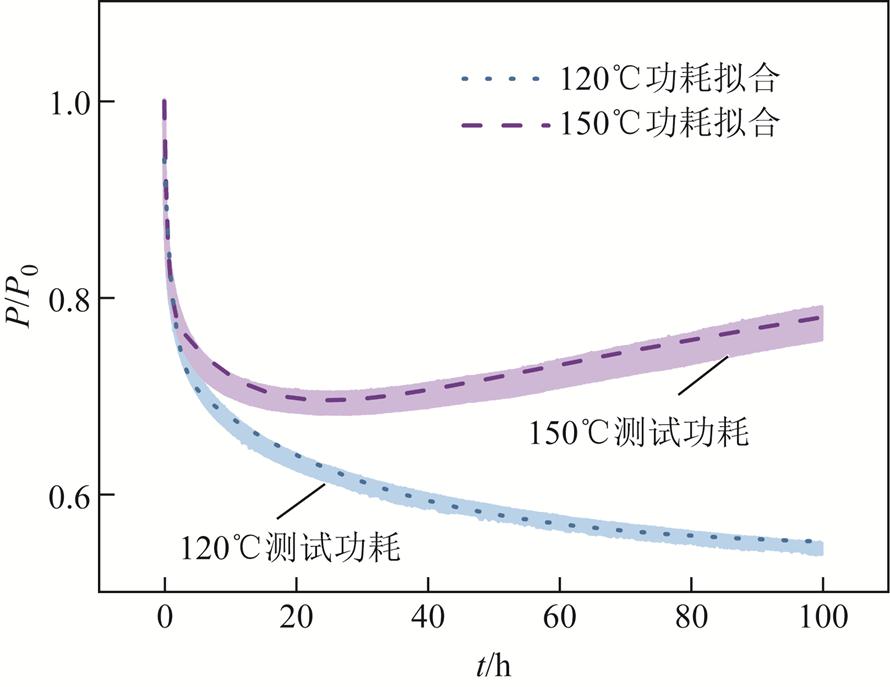
图2 120℃与150℃下稳定型氧化锌压敏电阻的归一化功耗曲线
Fig.2 Power loss curves of stable ZnO varistor ceramics at 120℃and 150℃
120℃下的功耗下降曲线可由双指数下降函数拟合为
 (1)
(1)
150℃下功耗的先降后升可由双指数下降函数及幂函数(t0.5)共同拟合为
 (2)
(2)
根据式(2)可知,150℃相对120℃指数项代表的松弛时间明显减小,表明温度升高使得功耗在前期下降更快。结合老化后期P/P0µt0.5,即典型不稳定型氧化锌压敏电阻的老化功耗特征[12, 37-39],可以判断当老化温度升高至150℃后,试样由稳定型氧化锌压敏电阻转变为介稳型氧化锌压敏电阻。
此外,功耗(泄漏电流密度J)随时间的变化本质上是晶界势垒高度fb的演变[25],即
 (3)
(3)
式中,A*为有效Richardson常数;T为热力学温度;e为元电荷;xb为本征费米能级相对导带底的高度;k为玻耳兹曼常数;U为外施偏压。由于J与fb呈负相关,功耗由降转升即代表晶界势垒高度由升转降。
未老化、老化后及恢复后试样的非线性J-E特性曲线如图3所示。老化过程中120℃和150℃下正、反向非线性J-E特性均表现出类似的不对称性:正向J-E曲线出现“交叉”现象,低电场区泄漏电流向增大方向移动,高电场区泄漏电流反而减小;反向J-E曲线则整体向泄漏电流增大方向移动。二者主要区别在于,150℃老化下J-E曲线的劣化程度相对于120℃老化更加显著,且150℃老化后J-E曲线难以恢复。当撤去老化电压后,120℃老化试样基本能够恢复到未老化状态;而150℃老化后正、反向J-E曲线虽然能够基本恢复到对称,但与未老化状态仍有一定的差距。根据DIR模型,120℃下晶界界面态保持稳定,因而J-E特性的演变主要源于耗尽层的离子重排,撤去电压后,耗尽层将逐渐恢复到未老化状态;而150℃下由于氧化锌压敏电阻由稳定型向介稳型转变,晶界界面态出现不可逆的消耗,J-E曲线仅能部分恢复。
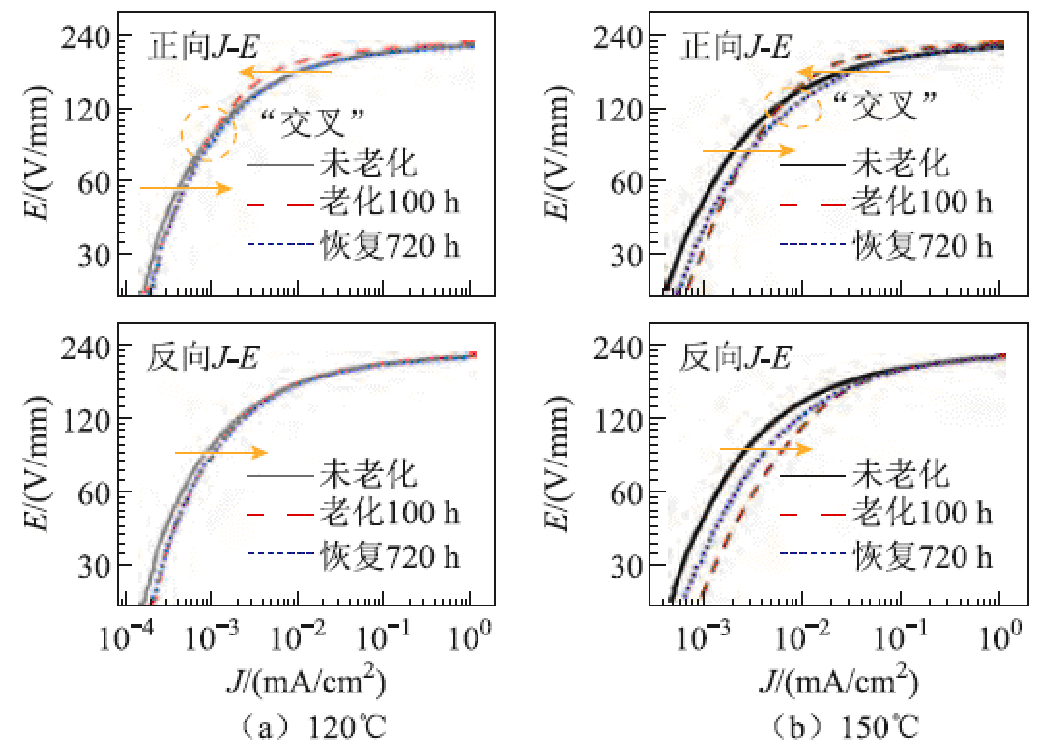
图3 120℃与150℃老化及恢复过程的非线性J-E特性曲线
Fig.3 Evolution of nonlinear J-E characteristics during aging and recovery at 120℃ and 150℃
根据非线性J-E曲线,可进一步计算试样的非线性系数a=1/lg(Ub/U0.1mA)(U0.1mA为J=0.1 mA/cm2时的电压)、击穿场强Eb=Ub/h以及泄漏电流JL(JL为0.75Ub时的泄漏电流)的变化,计算结果如图4和表1所示。类似地,150℃下试样的电气参数劣化更加明显,如反向非线性系数α从21.7降至17.6,JL从20.36 μA/cm²增加到34.05 μA/cm²;尽管经过720 h的恢复,其电气参数距未老化仍有不小的差距。
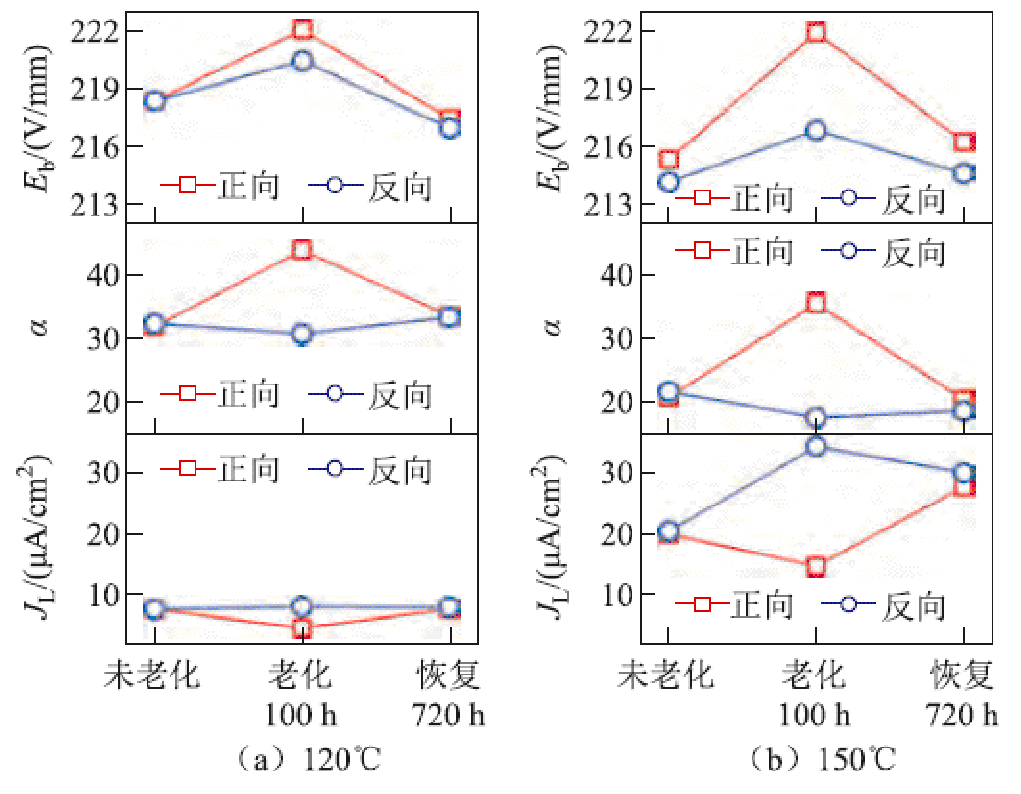
图4 120℃与150℃老化及恢复过程电气参数演变
Fig.4 Evolution of electrical parameters during aging and recovery at 120℃ and 150℃
表1 120℃与150℃下老化及恢复过程电气参数变化
Tab.1 Evolution of electrical parameters during aging and recovery at 120℃ and 150℃
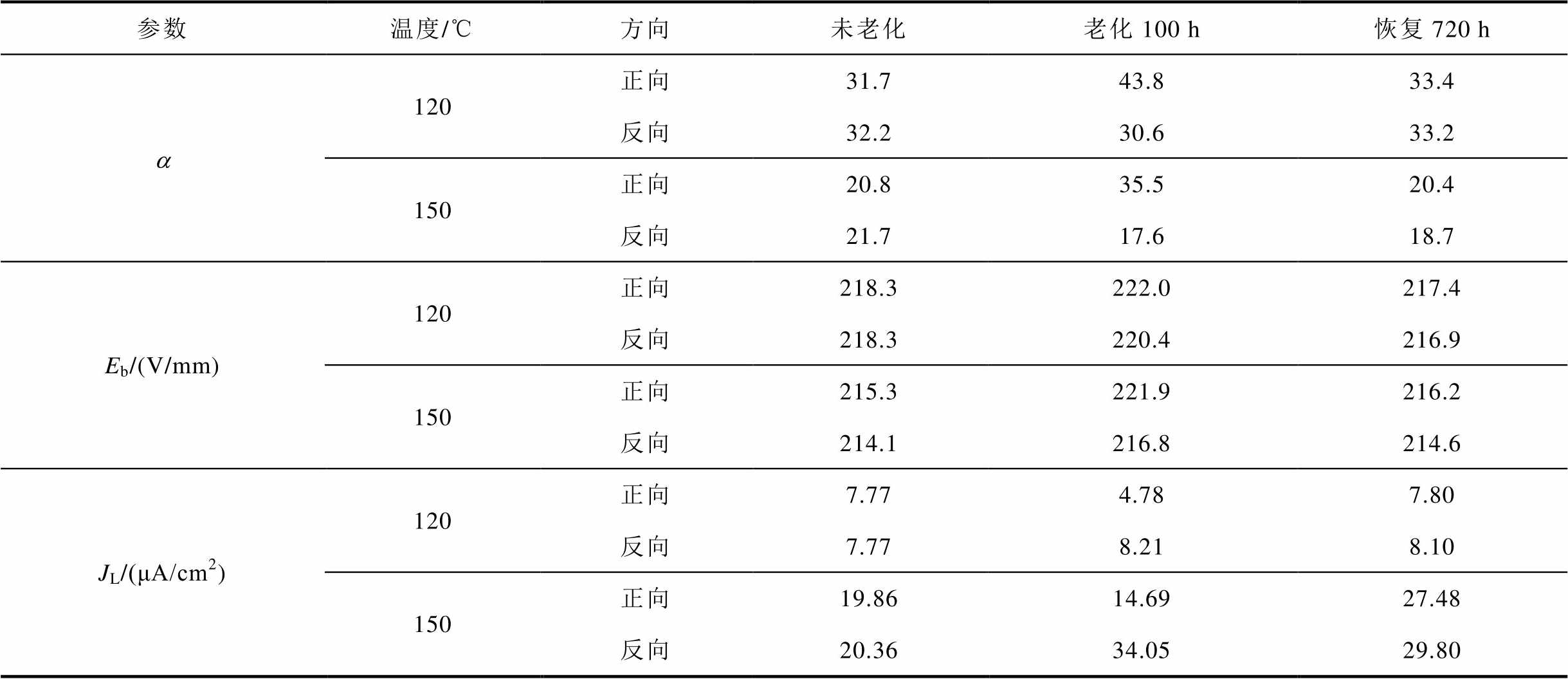
参数温度/℃方向未老化老化100 h恢复720 h a120正向31.743.833.4 反向32.230.633.2 150正向20.835.520.4 反向21.717.618.7 Eb/(V/mm)120正向218.3222.0217.4 反向218.3220.4216.9 150正向215.3221.9216.2 反向214.1216.8214.6 JL/(μA/cm2)120正向7.774.787.80 反向7.778.218.10 150正向19.8614.6927.48 反向20.3634.0529.80
为研究氧化锌压敏电阻的高温介电响应特性演变,本文选用一种改进的对导数谱图(∂e'/∂lnω)/e'-f,可以排除直流电导,将介电松弛过程以松弛峰的形式展现出来[40-41],具体表示为
 (4)
(4)
式中, 为介电常数实部;w为角频率,w=2pf,f为频率;t为松弛时间;
为介电常数实部;w为角频率,w=2pf,f为频率;t为松弛时间; 和
和 分别为静态和光频相对介电常数。零偏下未老化氧化锌压敏电阻的高温介电响应如图5所示,在10~104 Hz之间存在一个显著的松弛峰C,0.1~10 Hz附近存在松弛峰D。以上松弛峰在模量谱中也曾报道,属于非本征松弛缺陷。一般认为松弛峰C与制作工艺和添加剂相关,起源于晶界界面的空间电荷极化;松弛峰D则被认为与电性能和长期稳定性相关,起源于势垒界面态缺陷[31, 42-43]。以上松弛峰均随着温度升高向高频方向移动,满足Cole-Cole松弛形式,可基于Arrhenius公式计算其活化能Ea的大小,有
分别为静态和光频相对介电常数。零偏下未老化氧化锌压敏电阻的高温介电响应如图5所示,在10~104 Hz之间存在一个显著的松弛峰C,0.1~10 Hz附近存在松弛峰D。以上松弛峰在模量谱中也曾报道,属于非本征松弛缺陷。一般认为松弛峰C与制作工艺和添加剂相关,起源于晶界界面的空间电荷极化;松弛峰D则被认为与电性能和长期稳定性相关,起源于势垒界面态缺陷[31, 42-43]。以上松弛峰均随着温度升高向高频方向移动,满足Cole-Cole松弛形式,可基于Arrhenius公式计算其活化能Ea的大小,有
 (5)
(5)
式中,fm为特征频率;f0为前置系数。计算结果如图5内插图所示,未老化试样的松弛峰C活化能Ea= 0.583 eV,松弛峰D活化能Ea=0.654 eV。

图5 零偏下未老化氧化锌压敏电阻的高温介电响应
Fig.5 Dielectric spectra of the unaged ZnO varistor at different temperatures under zero bias
原位介电测试过程中,由于外施直流老化电压的影响,一方面,势垒高度较零偏压明显下降,影响松弛D的表征;另一方面,直流分量显著,导致低频交流小信号的测试精度下降,因而低频部分测试结果的分散性较大,此处仅讨论松弛C在老化过程中的改变。其中,120℃及150℃老化过程中松弛C的演变如图6所示,其中插图为所有的测试曲线。对于120℃老化,曲线整体基本保持稳定。然而,150℃老化过程中松弛C的峰值频率明显向高频移动,且高频部分出现了抬升。这与之前报道的低温下不稳定型氧化锌压敏电阻的低频损耗(对应松弛C的高频部分)抬升类似[26]。特征频率的增大表明晶界界面空间电荷极化速度在老化后更快,即晶界晶间相空间电荷极化时间减小。

图6 老化过程中松弛C的演变
Fig.6 Evolution of the relaxation C during aging
为进一步研究稳定型氧化锌压敏电阻向介稳型转变对高温松弛过程的影响,分别测试了120℃与150℃老化恢复后,零偏压下高温介电响应特性如图7和图8所示,并通过Arrhenius公式计算了松弛C和D的活化能见表2。120℃老化恢复后,松弛C和D的活化能大小基本与未老化状态一致,晶界保持稳定。而150℃下转变为介稳型后,松弛C和D的活化能均下降,难以恢复到未老化状态:松弛C的活化能由0.583 eV下降到0.560 eV,松弛D的活化能由0.654 eV下降到0.626 eV。进一步证明了高温将破坏晶界界面态的稳定性,并使晶界理化结构出现转变。
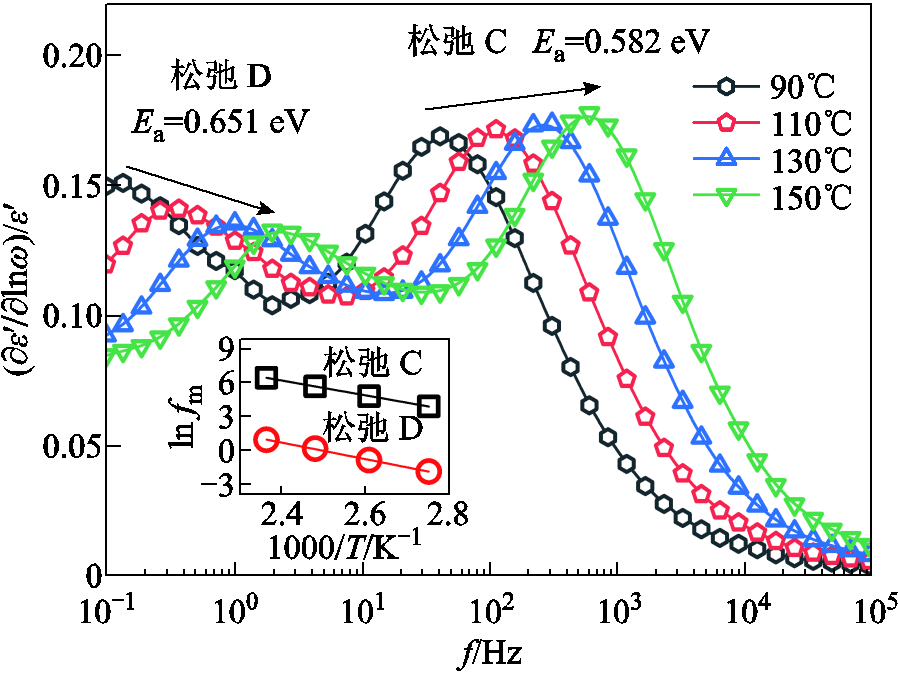
图7 120℃老化恢复后氧化锌压敏电阻不同温度下的零偏高温介电响应
Fig.7 Dielectric spectra of the recovered ZnO varistor ceramic under zero bias after aged at 120℃
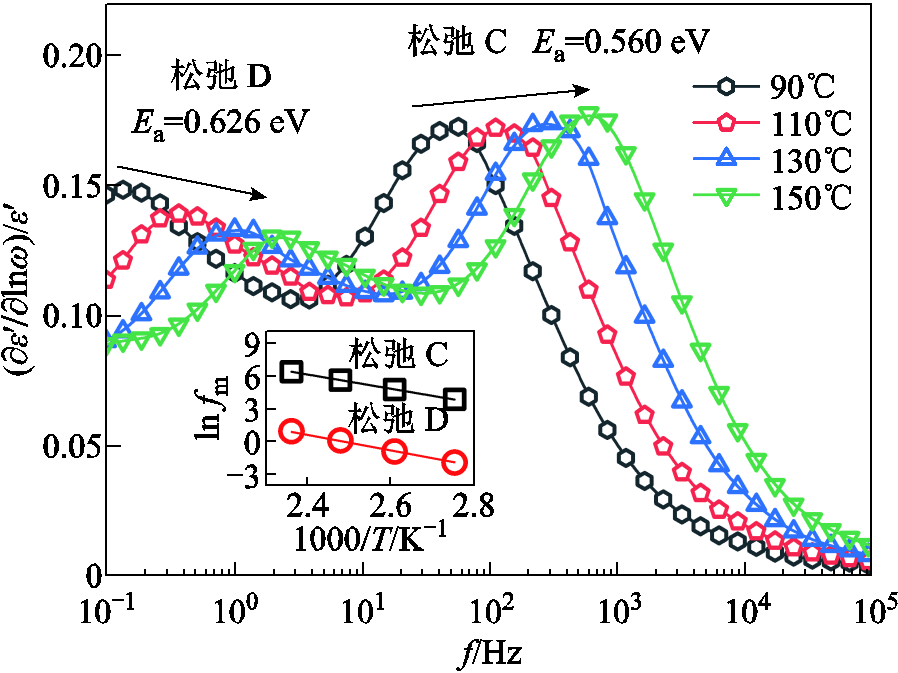
图8 150℃老化恢复后氧化锌压敏电阻不同温度下的零偏高温介电响应
Fig.8 Dielectric spectra of the recovered ZnO varistor ceramic under zero bias after aged at 150℃
表2 老化恢复后的松弛过程C和D的活化能
Tab.2 Evolution of Ea for relaxations C and D(单位:eV)

松弛过程未老化120℃老化恢复后150℃老化恢复后 C0.5830.5820.560 D0.6540.6510.626
本征点缺陷是构成晶界势垒的核心,通过测试不同温度老化过程中低温介电响应的演变,可获得稳定型氧化锌压敏电阻转变后本征点缺陷结构的演变[44]。不同温度老化过程中的低温介电响应如图9所示,102~104 Hz高频松弛A与1~100 Hz低频松弛B分别对应Zni˙˙和VO˙在晶界耗尽层边缘的脱陷和入陷过程[31]。由于老化过程的离子迁移及扩散作用,松弛A和B的强度均在老化后下降。当150℃老化下试样转为介稳型后,低温低频部分明显抬升,对应图5的松弛C向高频方向移动。恢复过程中,松弛A和B的演变如图10所示,随着恢复时间延长其强度逐渐上升,120℃老化试样基本恢复到未老化状态,但150℃老化试样的低频松弛部分难以恢复。
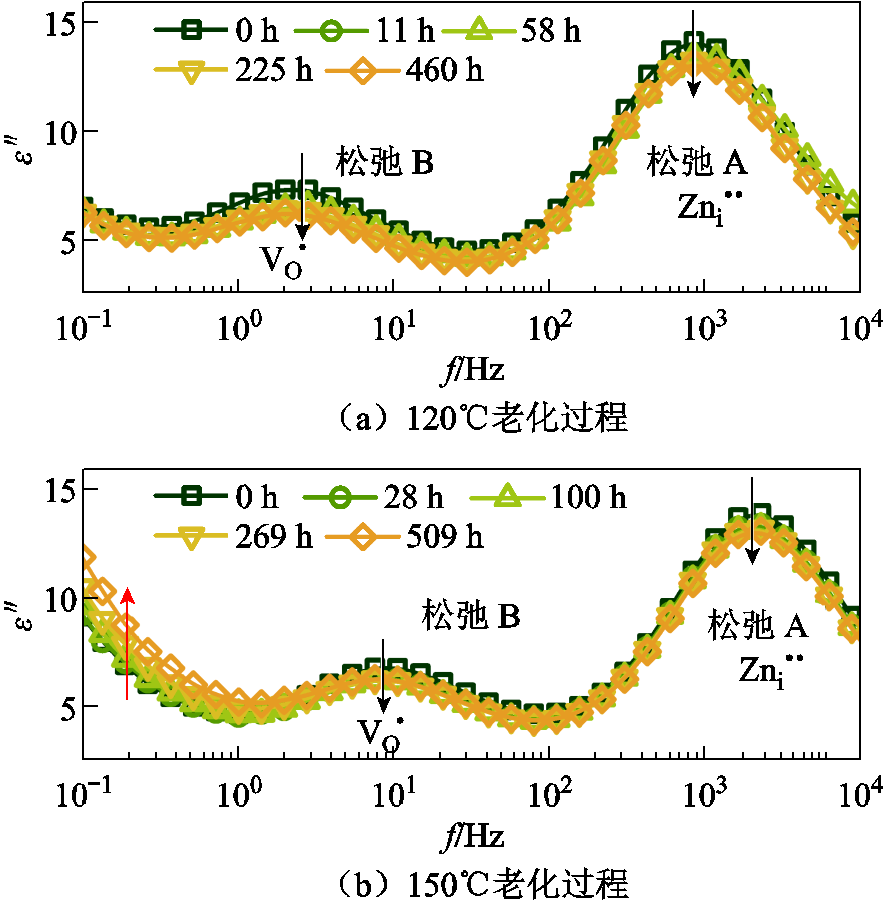
图9 老化过程中低温介电响应演变
Fig.9 Evolution of the low-temperature dielectric relaxations during the aging
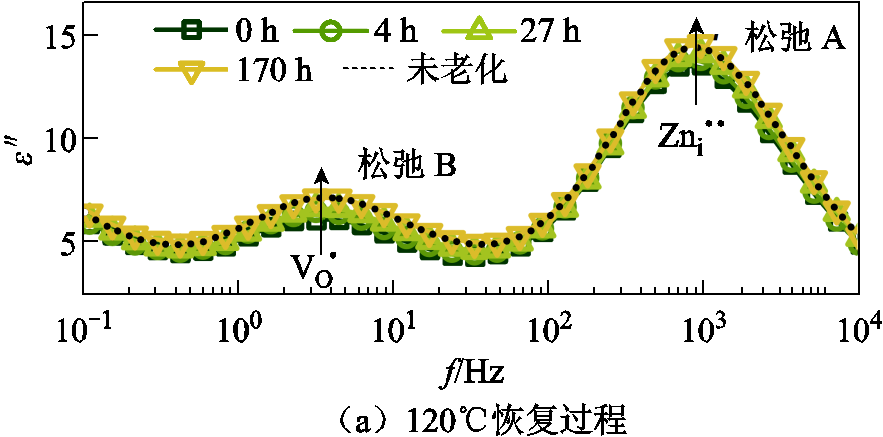

图10 恢复过程中低温介电响应演变
Fig.10 Evolution of the the low-temperature dielectric relaxations during the recovery
为量化Zni˙˙和VO˙的变化,根据Cole-Cole公式可对图9和图10的e″-f谱进行拟合[26],得到
 (6)
(6)
式中, 为真空介电常数;
为真空介电常数; 为介质损耗虚部;sDC为直流电导;Dei、ti和ai分别为第i个松弛的强度、松弛时间及松弛时间的分散程度,其中0<
为介质损耗虚部;sDC为直流电导;Dei、ti和ai分别为第i个松弛的强度、松弛时间及松弛时间的分散程度,其中0< <1。老化及恢复过程中松弛A和B的强度变化拟合结果如图11所示,图中,DeA和DeB分别代表Zni˙˙和VO˙松弛强度的变化。可以发现,老化和恢复过程中本征点缺陷变化主要集中在前20 h内,而后变化缓慢。其中120℃老化后DeA从38.1降至35.3,而后恢复到38.0;DeB从17.2降至14.7而后恢复到17.1。150℃老化下,DeA从36.2降至33.5;DeB从14.2降至12.8,而后二者分别恢复到36.0和13.9。代表Zni˙˙的DeA距离未老化状态仍有一定的差距,表明氧化锌压敏电阻由稳定型转为介稳型后出现了不可逆的消耗,即锌填隙与晶界界面态发生了中和反应。
<1。老化及恢复过程中松弛A和B的强度变化拟合结果如图11所示,图中,DeA和DeB分别代表Zni˙˙和VO˙松弛强度的变化。可以发现,老化和恢复过程中本征点缺陷变化主要集中在前20 h内,而后变化缓慢。其中120℃老化后DeA从38.1降至35.3,而后恢复到38.0;DeB从17.2降至14.7而后恢复到17.1。150℃老化下,DeA从36.2降至33.5;DeB从14.2降至12.8,而后二者分别恢复到36.0和13.9。代表Zni˙˙的DeA距离未老化状态仍有一定的差距,表明氧化锌压敏电阻由稳定型转为介稳型后出现了不可逆的消耗,即锌填隙与晶界界面态发生了中和反应。

图11 老化及恢复过程中松弛A和B的强度变化
Fig.11 Evolution of intensities of relaxations A and B during aging and recovery
为进一步研究稳定型氧化锌压敏电阻的高温转变特性,根据图1所示测试系统,分别测试了30℃及180℃下的老化特性,并通过XRD和XPS测试转变后的相组成和Zn2p元素状态变化。
30℃及180℃的老化功耗曲线如图12所示。30℃老化功耗持续下降,表现为稳定型老化特性;180℃功耗随老化时间延长不断上升,经拟合得到
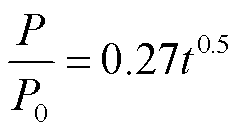 (7)
(7)
可知P/P0µt0.5,符合不稳定型氧化锌压敏电阻的功耗趋势。经过200 h,180℃下老化功耗约变为初始值的4倍,试样出现严重老化。

图12 30℃和180℃下稳定型氧化锌压敏电阻直流老化功耗曲线
Fig.12 Power loss curves of stable ZnO varistor ceramics during DC aging at 30℃and 180℃
180℃老化过程中试样的非线性I-U特性变化如图13所示。此时正向I-U曲线不再出现“交叉”现象,正、反向I-U曲线均随着老化时间延长向泄漏电流增大的方向移动,且前18 h就出现明显的劣化,反向较正向劣化更加严重,进一步表明氧化锌压敏电阻由稳定型向不稳定型的转变。
根据I-U曲线,提取180℃老化过程电气参数变化如图14所示。无论是正向还是反向的电气参数都出现了明显劣化,但反向参数劣化尤为严重:老化232 h后,U1mA从200.5 V下降到92.9 V,非线性系数a从16.3下降到2.0,泄漏电流从19.5 mA上升到479.3 mA。因此,当稳定型氧化锌压敏电阻转变为不稳定型后,电气性能将出现显著的老化,难以再满足过电压保护的需求,需重点关注。

图13 180℃直流过程非线性电压-电流特性演变
Fig.13 Evolution of nonlinear I-U curves during DC aging at 180℃
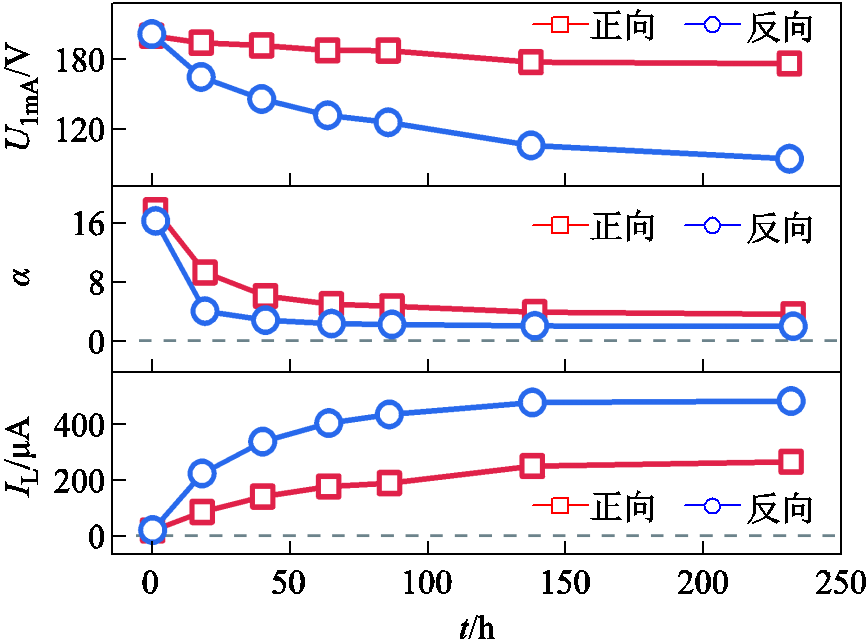
图14 180℃直流老化过程电气参数变化
Fig.14 Variations of electrical parameters in the forward and reverse directions during DC aging at 180℃
为探究稳定型氧化锌压敏电阻向不稳定型转变后理化结构的演变,首先通过XRD表征了未老化、30℃老化后、180℃老化后试样的ZnO晶相XRD衍射谱,如图15所示。根据JCPDS Card No. 36-1451,氧化锌存在三个主晶面:(100)、(002)及(101)[12]。未老化试样中以上三个晶面分别位于31.88°、34.55°和36.37°。以上衍射峰在经过30℃及180℃的直流老化后强度均有所下降。以(002)晶面为例,其变化如图15b和图15c所示。一方面,相较于30℃老化后(002)晶面衍射角基本不变,180℃直流老化后(002)晶面衍射角随老化向低角度方向移动,从34.55°下降到34.53°;另一方面,30℃老化后半峰宽(Full Width at Half Maxima, FWHM)略微下降,从0.154°下降到0.148°,而180℃老化后降至0.142°。

图15 未老化、30℃老化及180℃老化试样的XRD谱
Fig.15 XRD patterns of samples before aging, after aging at 30℃, and after aging at 180℃
根据布拉格方程,衍射角2q的减小对应晶面间距d及晶格常数c的增大[45],即
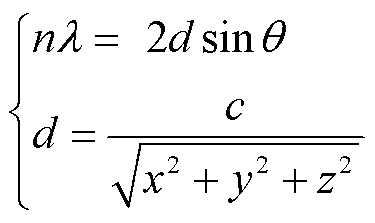 (8)
(8)
式中,n为衍射阶数;λ为X射线波长;x、y和z为晶面指数。因此,180℃下2q的减小、d及c的增大表明,氧化锌压敏电阻由稳定型向不稳定型转变后,氧化锌晶格间距增加,晶格常数增大。而半峰宽的下降与晶格畸变形成的内应力相关,佐证锌填隙的离子迁移过程,即迁移至晶界的锌填隙会增大氧化锌晶格内部的局部应力,且离子迁移过程越显著,半峰宽下降越明显。
进一步对未老化、30℃和180℃老化后试样的老化区进行XPS测试,通过C1s标准轨道峰校准,获得归一化后的Zn2p轨道峰的变化如图16所示。氧化锌压敏电阻试样的Zn2p轨道存在两个轨道峰,分别为Zn2p3/2以及Zn2p1/2。对于未老化试样,以上两个峰分别位于1 022.5 eV及1 045.9 eV;30℃老化后,Zn2p3/2和Zn2p1/2的峰位置基本不变;而180℃直流老化后,氧化锌压敏电阻由稳定型转变为不稳定型,Zn2p轨道明显向低结合能方向移动,Zn2p3/2和Zn2p1/2结合能分别下降到1 022.1 eV和1 045.2 eV,表明锌发生了还原反应[46],转变为Zni˙或中性晶格锌。锌填隙的还原过程来自其与晶界界面态的中和过程,即晶界界面态在高温下的稳定性被破坏后,将与Zni˙、Zni˙˙发生中和并被消耗,电气性能因此表现出显著劣化,并且老化不再可逆。

图16 30℃及180℃直流老化后Zn2p轨道变化
Fig.16 Zn2p spectra of samples aged at 30℃ and 180℃
本文对稳定型氧化锌压敏电阻在不同温度下进行加速直流老化实验。采用原位介电测试及离线理化结构测试,探究了高温下氧化锌压敏电阻由稳定型向介稳型和不稳定型的转变特性,为稳定型氧化锌压敏电阻的反常老化机制研究提供参考,得到结论如下:
1)随着直流老化温度的升高,稳定型氧化锌压敏电阻的功耗由120℃时的持续下降转变为150℃时的先降后升,最后在180℃下持续上升;功耗曲线由双指数下降形式转变为正比于老化时间的算术平方根t0.5;老化类型由稳定型向介稳型和不稳定型转变,电气性能在老化后难以恢复,老化不再可逆。
2)氧化锌压敏电阻由稳定型转变为不稳定型后,电气性能将显著劣化。180℃下老化232 h,功耗变为初始值的4倍;正向J-E特性曲线的“交叉”现象消失,正、反向J-E曲线均随老化时间延长向泄漏电流增大方向移动;反向电气参数劣化严重,泄漏电流从19.5 mA上升到479.3 mA。
3)氧化锌压敏电阻由稳定型向介稳型转变后,原位高温介电测试结果表明,代表晶界界面空间电荷极化过程的松弛峰向高频方向移动,松弛时间减小,活化能下降,且高频部分抬升,晶界空间电荷极化过程更迅速;低温介电测试表明,本征点缺陷锌填隙难以恢复到未老化的水平,出现了不可逆消耗。
4)氧化锌压敏电阻由稳定型转变为不稳定型后,离线理化结构测试结果表明,氧化锌晶面衍射角减小,晶格内原子之间的间距增加,对应晶界空间电荷极化时间缩短;而氧化锌晶面的半峰宽和衍射强度在老化后减小,表明老化过程中锌填隙由于离子重排在晶界处堆积,会引起氧化锌晶格内应力增大。另外,XPS结果表明晶界稳定性被破坏后,Zn2p轨道结合能减小,锌填隙被还原,即界面态失去稳定性后将与锌填隙发生中和反应,引起界面态密度下降,宏观表现为稳定型氧化锌压敏电阻老化不再可逆,电气性能明显劣化。
参考文献
[1] 何金良, 刘俊, 胡军, 等. 电力系统避雷器用ZnO压敏电阻研究进展[J]. 高电压技术, 2011, 37(3): 634-643.
He Jinliang, Liu Jun, Hu Jun, et al. Development of ZnO varistors in metal oxide arrestors utilized in ultra high voltage systems[J]. High Voltage Engineering, 2011, 37(3): 634-643.
[2] 王兰义, 任鑫, 黄海, 等. 国内外避雷器用氧化锌电阻片的技术现状与发展趋势[J]. 电瓷避雷器, 2021(6): 30-44.
Wang Lanyi, Ren Xin, Huang Hai, et al. The development trends of zinc oxide varistor used in surge arrester both in China and abroad[J]. Insulators and Surge Arresters, 2021(6): 30-44.
[3] 孟鹏飞, 郭敬科, 张恒志, 等. ZnO压敏电阻微观结构参数与宏观电气性能的关联机制[J]. 电工技术学报, 2024, 39(5): 1454-1463.
Meng Pengfei, Guo Jingke, Zhang Hengzhi, et al. The correlation mechanism that micro-structure parameters of ZnO varistor to the macroscopic electrical characteristics[J]. Transactions of China Electro-technical Society, 2024, 39(5): 1454-1463.
[4] 康晟淋, 赵学童, 张洁心, 等. 冷烧结技术的研究进展及其在电工领域的潜在应用[J]. 电工技术学报, 2022, 37(5): 1098-1114.
Kang Shenglin, Zhao Xuetong, Zhang Jiexin, et al. Recent research progress of cold sintering process and its potential application in electrotechnical fields[J]. Transactions of China Electrotechnical Society, 2022, 37(5): 1098-1114.
[5] 何俊佳, 宋丽, 周本正, 等. ZnO压敏电阻微观结构调控与性能提升研究综述[J]. 电工技术学报, 2023, 38(20): 5605-5619.
He Junjia, Song Li, Zhou Benzheng, et al. Review on microstructure control and performance improvement of ZnO varistors[J]. Transactions of China Electrotechnical Society, 2023, 38(20): 5605-5619.
[6] 赵江泽, 赵洪峰, 程宽, 等. 不同类型冲击电流对ZnO压敏电阻老化的影响研究[J]. 高压电器, 2024, 60(2): 127-132, 162.
Zhao Jiangze, Zhao Hongfeng, Cheng Kuan, et al. Research on influence of different types of impulse current on the aging of ZnO varistor[J]. High Voltage Apparatus, 2024, 60(2): 127-132, 162.
[7] Greuter F. ZnO varistors: from grain boundaries to power applications[M]//Ray A. Oxide Electronics. Chichester: John Wiley & Sons, Ltd, 2021: 157-234.
[8] 武康宁, 程卓林, 李柔, 等. 现代稳定型氧化锌压敏陶瓷的直流老化研究进展[J]. 高电压技术, 2024, 50(2): 621-633.
Wu Kangning, Cheng Zhuolin, Li Rou, et al. Research progress in DC aging of modern stable ZnO varistor ceramics[J]. High Voltage Engineering, 2024, 50(2): 621-633.
[9] 程宽, 赵洪峰, 周远翔. B2O3掺杂对直流ZnO压敏电阻老化特性的影响[J]. 电工技术学报, 2022, 37(13): 3413-3421.
Cheng Kuan, Zhao Hongfeng, Zhou Yuanxiang. Effect of B2O3 doping on the aging characteristics of DC ZnO varistor ceramics[J]. Transactions of China Electro-technical Society, 2022, 37(13): 3413-3421.
[10] 李盛涛, 刘辅宜, 宋晓兰, 等. 关于氧化锌非欧姆陶瓷老化机理的新见解[J]. 中国电机工程学报, 1993, 13(增刊1): 43-47.
Li Shengtao, Liu Fuyi, Song Xiaolan, et al. New idea of degradation mechanism of ZnO nonohmic ceramics [J]. Proceedings of the CSEE, 1993, 13(S1): 43-47.
[11] He Jinliang, Cheng Chenlu, Hu Jun. Electrical degradation of double-Schottky barrier in ZnO varistors[J]. AIP Advances, 2016, 6(3): 030701.
[12] Guo Men, Zhao Xia, Shi Weidong, et al. Simultaneously improving the electrical properties and long-term stability of ZnO varistor ceramics by reversely manipulating intrinsic point defects[J]. Journal of the European Ceramic Society, 2022, 42(1): 162-168.
[13] 马御棠, 束洪春, 钱国超, 等. 基于频域介电谱曲线分解的氧化锌避雷器老化状态评估[J]. 电工技术学报, 2024, 39(3): 901-913.
Ma Yutang, Shu Hongchun, Qian Guochao, et al. Method for evaluating the aging state of ZnO arrester based on curve decomposition of frequency domain dielectric spectrum[J]. Transactions of China Electrotechnical Society, 2024, 39(3): 901-913.
[14] Gupta T K, Carlson W G. A grain-boundary defect model for instability/stability of a ZnO varistor[J]. Journal of Materials Science, 1985, 20(10): 3487-3500.
[15] CIGRE Working Group A3.17. MO surge arresters - stresses and test procedures[R]. Paris: CIGRE, 2013.
[16] CIGRE Working Group A3.25. MO surge arresters – metal oxide resistors and surge arresters for emerging system conditions[R]. Paris: CIGRE, 2017.
[17] Sato K, Takada Y, Maekawa H, et al. Electrical conduction of ZnO varistors under continuous DC stress[J]. Japanese Journal of Applied Physics, 1980, 19(5): 909.
[18] Sato K, Takada Y, Takemura T, et al. A mechanism of degradation in leakage currents through ZnO varistors[J]. Journal of Applied Physics, 1982, 53(12): 8819-8826.
[19] 李慧峰, 王士良, 许毓春, 等. 氧化锌非线性电阻冲击老化机理的研究[J]. 中国电机工程学报, 1993, 13(增刊1): 25-31.
Li Huifeng, Wang Shiliang, Xu Yuchun, et al. Pulse degradation mechanism of non-ohmic ZnO ceramics[J]. Proceedings of the CSEE, 1993, 13(S1): 25-31.
[20] Takahashi K, Miyoshi T, Maeda K, et al. Degradation of zinc oxide varistors[J]. MRS Online Proceedings Library, 1981, 5(1): 399-404.
[21] Stucki F, Greuter F. Key role of oxygen at zinc oxide varistor grain boundaries[J]. Applied Physics Letters, 1990, 57(5): 446-448.
[22] Bueno P R, Leite E R, Oliveira M M, et al. Role of oxygen at the grain boundary of metal oxide varistors: a potential barrier formation mechanism[J]. Applied Physics Letters, 2001, 79(1): 48.
[23] International Electrotechnical Commission. Surge arresters part 4: metal-oxide surge arresters without gaps for a.c. systems: IEC 60099-4:2014[S]. Geneva: IEC, 2014.
[24] Cheng Zhuolin, Hou Zongke, Wu Tong, et al. Transient conduction of ZnO varistors under moderate time-varying voltages: dynamics of interfacial charges of the double Schottky barrier[J]. Journal of Applied Physics, 2023, 133(5): 054101.
[25] Blatter G, Greuter F. Carrier transport through grain boundaries in semiconductors[J]. Physical Review B, Condensed Matter, 1986, 33(6): 3952-3966.
[26] Cheng Zhuolin, Hou Zongke, Wang Yao, et al. Steadily decreasing power loss of a double Schottky barrier originating from the dynamics of mobile ions with stable interface states[J]. Physical Review Applied, 2022, 17(3): 034042.
[27] 江海波, 任鑫, 劳学斌, 等. 镓离子掺杂量对ZnO压敏电阻性能的影响[J]. 电瓷避雷器, 2023(4): 46-50.
Jiang Haibo, Ren Xin, Lao Xuebin, et al. Effect of Ga3+ doping content on the properties of ZnO-based varistors[J]. Insulators and Surge Arresters, 2023(4): 46-50.
[28] 王瑶, 张磊, 席子晗, 等. 气孔和晶粒尺寸不均匀系数对方波脉冲大电流作用下高电位梯度氧化锌陶瓷失效的影响[J]. 电瓷避雷器, 2021(5): 149-155, 163.
Wang Yao, Zhang Lei, Xi Zihan, et al. Effects of pores and non-uniform coefficient of the grain size on failure of high gradient zinc oxide varistor block under the square wave pulse current[J]. Insulators and Surge Arresters, 2021(5): 149-155, 163.
[29] Wu Kangning, Wang Yao, Hou Zongke, et al. Colossal permittivity due to electron trapping behaviors at the edge of double Schottky barrier[J]. Journal of Physics D: Applied Physics, 2021, 54(4): 045301.
[30] Greuter F, Blatter G. Electrical properties of grain boundaries in polycrystalline compound semi-conductors[J]. Semiconductor Science Technology, 1990, 5(2): 111-137.
[31] Zhao Xuetong, Li Jianying, Li Huan, et al. Intrinsic and extrinsic defect relaxation behavior of ZnO ceramics[J]. Journal of Applied Physics, 2012, 111(12): 124106.
[32] Wu Kangning, Hou Zongke, Cheng Zhuolin, et al. Revisiting the feasibility of distinguishing the long-term stability of MOVs by power loss[J]. IEEE Transactions on Dielectrics and Electrical Insulation, 2022, 29(5): 1983-1990.
[33] Cheng Zhuolin, Li Rou, Long Yiwei, et al. Power loss transition of stable ZnO varistor ceramics: role of oxygen adsorption on the stability of interface states at the grain boundary[J]. Journal of Advanced Ceramics, 2023, 12(5): 972-983.
[34] Li Rou, Cheng Zhuolin, Gao Ao, et al. Transition from non-Arrhenius to Arrhenius aging of ZnO ceramics [C]//2023 IEEE 4th International Conference on Electrical Materials and Power Equipment (ICEMPE), Shanghai, China, 2023: 1-4.
[35] Zhao Xia, Guo Men, Zhang Zhaohua, et al. Enhancement in the long-term stability of ZnO varistor ceramics against DC aging by controlling intergranular phases[J]. Journal of Alloys and Compounds, 2022, 894: 162543.
[36] Wang Xin, Ren Xin, Li Zhuyun, et al. A unique tuning effect of Mg on grain boundaries and grains of ZnO varistor ceramics[J]. Journal of the European Ceramic Society, 2021, 41(4): 2633-2640.
[37] Leite E R, Varela J A, Longo E. A new interpretation for the degradation phenomenon of ZnO varistors[J]. Journal of Materials Science, 1992, 27(19): 5325-5329.
[38] Gupta T K, Carlson W G, Hower P L. Current instability phenomena in ZnO varistors under a continuous ac stress[J]. Journal of Applied Physics, 1981, 52(6): 4104-4111.
[39] Tada T. Degradation of ZnO varistors as estimated by aging tests[J]. Electrical Engineering in Japan, 2010, 170(2): 1-18.
[40] 武康宁, 黄雨薇, 王子悦, 等. 电介质的衍生对导数介电分析方法及其应用[J]. 高电压技术, 2020, 46(2): 640-647.
Wu Kangning, Huang Yuwei, Wang Ziyue, et al. Application of extended derivative method in analyzing dielectric responses of dielectrics[J]. High Voltage Engineering, 2020, 46(2): 640-647.
[41] Wu Kangning, Huang Yuwei, Li Jianying, et al. Space charge polarization modulated instability of low frequency permittivity in CaCu3Ti4O12 ceramics[J]. Applied Physics Letters, 2017, 111(4): 042902.
[42] Huang Yuwei, Guo Men, Li Jianying. Multiscale defect responses in understanding degradation in zinc oxide varistor ceramics[J]. Ceramics International, 2020, 46(14): 22134-22139.
[43] 赵学童, 李建英, 贾然, 等. 直流老化及热处理对ZnO压敏陶瓷缺陷结构的影响[J]. 物理学报, 2013, 62(7): 418-424.
Zhao Xuetong, Li Jianying, Jia Ran, et al. The effect of DC degradation and heat-treatment on defects in ZnO varistor[J]. Acta Physica Sinica, 2013, 62(7): 418-424.
[44] Huang Yuwei, Wu Kangning, Xing Zhaoliang, et al. Understanding the validity of impedance and modulus spectroscopy on exploring electrical heterogeneity in dielectric ceramics[J]. Journal of Applied Physics, 2019, 125(8): 084103.
[45] Bindu P, Thomas S. Estimation of lattice strain in ZnO nanoparticles: X-ray peak profile analysis[J]. Journal of Theoretical and Applied Physics, 2014, 8(4): 123-134.
[46] Zhang Yuantao, Du Guotong, Wang Xinqiang, et al. X-ray photoelectron spectroscopy study of ZnO films grown by metal-organic chemical vapor deposition[J]. Journal of Crystal Growth, 2003, 252(1/2/3): 180-183.
Transition Characteristics of Stable ZnO Varistors During DC Aging at High Temperatures
Abstract Metal oxide surge arresters are crucial for overvoltage protection in power systems, determining the insulation level of electrical equipment, with their core component being the ZnO varistor. However, modern stable ZnO varistors exhibit an anomalous decrease in power loss during aging, contradicting the increase in power loss predicted by the classical ion migration model. This discrepancy poses challenges for the condition assessment and life prediction of ZnO varistors due to a lack of theoretical foundations, thereby presenting a potential threat to the power system. Consequently, the study of the anomalous aging mechanism of stable ZnO varistors has been identified as a major challenge for the varistor community by CIGRE in both 2013 and 2017.
In this paper, stable ZnO varistors are subjected to accelerated DC aging at elevated aging temperatures to investigate their long-term stability transition. With increase in aging temperature, power loss trend transitions from a continuous decrease at 120℃ to an initial decrease followed by an increase at 150℃, and a sustained rise at 180℃. The decreasing power loss trend can be fitted by a double exponential decay function, while the increasing power loss is proportional to the square root of the aging time t0.5. After transitioning to a mixed stable type at 150℃, the aging of stable ZnO varistors becomes irreversible. In-situ high-temperature dielectric measurements reveal that the interface space charge polarization relaxation process shifts to higher frequencies with decreased relaxation time and activation energy decreasing from 0.583 eV to 0.560 eV, indicating the destruction of the grain boundary structure. Low-temperature dielectric tests show that intrinsic point defects of zinc interstitials undergo irreversible consumption after aging. Upon transitioning to an instable type at 180℃, the "crossover" phenomenon of the forward current-voltage (I-U) characteristics disappears at 180℃, and both forward and reverse I-V characteristics shift towards increased leakage current region as a whole. Severe deterioration in reverse electrical parameters was observed, as breakdown voltage U1mA decreases from 200.5 V to 92.9 V, the nonlinear coefficient α decreases from 16.3 to 2.0, and the leakage current rises from 19.5 μA to 479.3 μA. More importantly, offline physical and chemical structural tests show a reduction in the diffraction angles of ZnO crystal planes and decreased peak intensities. Additionally, a significant decrease in the binding energy of the Zn2p orbital is observed, with Zn2p3/2 and Zn2p1/2 orbitals decreasing from 1 022.5 eV and 1 045.9 eV to 1 022.1 eV and 1 045.2 eV, respectively. This indicates the reduction of zinc interstitials and confirming that the interface states cannot maintain stability at high temperatures, thus becoming neutralized and consumed with zinc interstitials.
These findings demonstrate that the essence of the decreasing power loss in stable ZnO varistors lies in the stable interface states at the grain boundary, which, however, cannot maintain stable at certain high temperatures. The interface states would then neutralize with the zinc interstitials due ion migration, subsequently leading to the reduction of zinc interstitials and the destruction of the ZnO lattice, resulting in significant deterioration of ZnO varistors. Therefore, optimizing the high-temperature stability of the interface states is crucial for enhancing the long-term stability of ZnO varistors.
Keywords:ZnO, varistors, DC aging, arrester, long-term stability
中图分类号:TM286;TM862
DOI: 10.19595/j.cnki.1000-6753.tces.240759
国家自然科学基金(52107027, 51937008, 52207022)、中国博士后基金(2022M722513)和电力设备电气绝缘国家重点实验室中青年基金(EIPE22310)资助项目。
收稿日期2024-05-12
改稿日期2024-07-04
程卓林 男,1997年生,博士研究生,研究方向为稳定型氧化锌压敏陶瓷的直流老化机制。
E-mail:czlxjt@stu.xjtu.edu.cn
李建英 男,1972年生,教授,博士生导师,研究方向为电介质理论及其应用、先进电工材料等。
E-mail:lijy@xjtu.edu.cn(通信作者)
(编辑 李 冰)